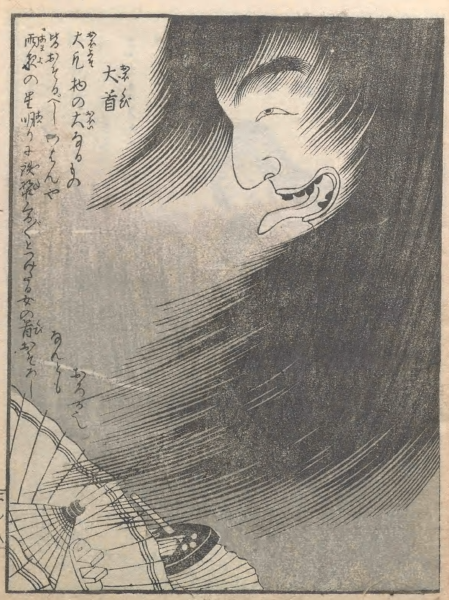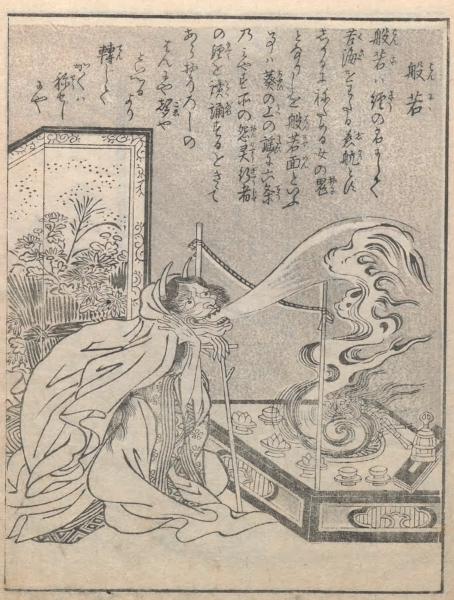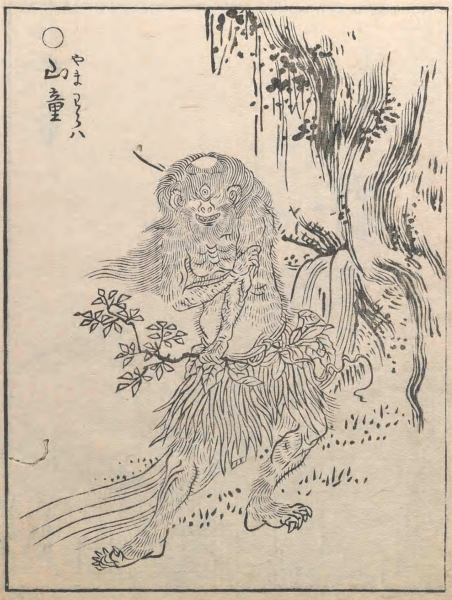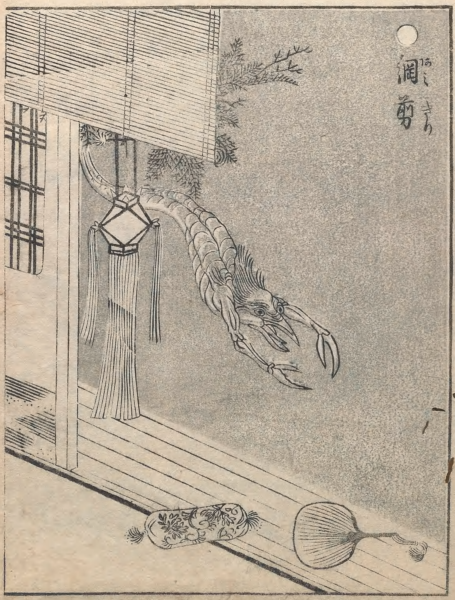The second in Sekien’s parade of Ghost Books is the Konjaku zoku hyakki 今昔続百鬼 also found with the title Konjaku gazu – Zoku hyakki 今昔畫圖 続百鬼 of 1779. It is again in the hanshibon format and comprised of three volumes. I couldn’t find a complete set of images of a first edition copy on the internet—the British Museum has two copies and cites somewhat strange dates for them and only pics of three pages. A copy of the 1805 reprint in the collection of the Smithsonian Institution, Washington, is as follows:

Courtesy Smithsonian Institution, Washington
Konjaku gazu – Zoku hyakki 今昔畫圖 続百鬼 – 3 vols hanshibon Vol 1 – U 雨 (Rain) 10 sh: 4 pp pref headed Hyakki yagyō daiji 百鬼夜行 題辞 (prefatory motto) signed Katakian Dōjin 頑菴道人 s: Katakian Dōjin, xxkin no shō, 印: 頑菴道人, □瑾之章, of the Sengyūkan at the Kichijōrin (the Kichijō Grove, probably near Kichijō Temple, or in the village named after it), in the Nippori District in the Eastern Capital (Edo) 東都日莫里吉祥林之穿牛觀 dated Anei tsuchinoe inu kishū no hi 安永戊戌季秋日 (Anei year of the Dog, one Autumn day, IX/1778); 2 pp pref preceded by the seal Reiryōdō 零陵洞 (one of Sekien’s art names) signed Toriyama Sekien 鳥山石燕 s: unread, Sekien no in 印:□, 石燕之印; 1 p contents; 13 pp ills. Vol 2 – Kau 晦 (Darkness) 11 sh: 1 p contents; 21 pp ills. Vol 3 – Mei 明 (Clearness) 11 sh: 1 p contents; 21 pp ills; ibc colophon: Toriyama Sekien Toyofusa 鳥山石燕豊房/ assisted by his pupils 校合門人 Shikō 子興 (Eishōsai Chōki 栄松齋長喜)/ Enji 燕二/ Enjū 燕十(Shimizu Enjū 志水燕十 1747-1810)/ Anei hachi tsuchinoto i no haru 安永八己亥春 (Anei 8 year of the Boar [I/1779])/ Bunka ni kinoto ushidoshi kyūhan 文化二乙丑年求板 (reprinted Bunka 2 year of the Ox [1805])/ block-cutter Machida Sukeemon 町田助右衛門/ Edo bookshops Maekawa Rokuzaemon 江戸 前川六左衛門/ Maekawa Yahei 前川弥兵衛.
Another copy with the 1805 dating, published by Maekawa Magobei 前川孫兵衛 and Maekawa Rokuzaemon 前川六左衛門, has only the Sekien preface (National Museum of Ethnology, Leiden RV-1-4459 — and was probably bought by Siebold in 1826). This is apparently also the case with the Regamey copy, as Joly & Inada only give a translation of the Sekien preface.

Courtesy Smithsonian Institution, Washington
The Sekien preface reads as follows:
From very ancient times hundreds of devils and Bakemono [ghosts and apparitions] have been depicted by Jozu (上手 experts) and handed down in various families. As I was asked to copy them with my unskilled brush, I became very greatly interested, for there were so many dreadful bakemono that I was afraid the real devil might suddenly appear (to me) in this world. The publisher of my previous books asked me for this volume as an addition to the last one and I have accepted his offer.
The Sekien prefaces and postscripts are admittedly not extremely inspired, but in view of Sekien’s quite specific remark on the problem ’to make the faces of the ghosts that we cannot see with our eyes frightening’ and his likening this to ‘a dragon that might appear,’ the Yoda & Alt translation is more faithful to the original:
Since times of old, the night parade of the demon horde has been passed down, copied and kept in the houses of the great masters. Here I have acquiesced to demands to apply my humble techniques to the topic. There’s no hope of achieving realism when it comes to the fearsome faces of things that can’t be seen with the human eye, but I can at least shock and awe, and so I have tried my best with humble skills to capture their bizarre forms once again. Running my fingers over my beloved earlier work, I mused: I certainly love drawing this sort of thing, but what if a real demon showed up? When a certain man got a visit from a real dragon it was utterly terrifying.* But even still, when the bookseller pleaded for a sequel to my book of a few years back, I found it hard to refuse. And so I, Toriyama Sekien, find myself again taking up my brush under the moonlight.**
* (A Chinese parable about a magistrate named Ye who loved dragons so much that he decorated his entire house with dragon figures and motifs. And one day, an actual dragon dropped by to thank him. But upon seeing the “real deal,” Ye turned and ran in terror.)
** [‘under the moonlight’ reads as Gessō no moto 月窓下, ‘under my moonlit window,’ one of Sekien’s artnames]

